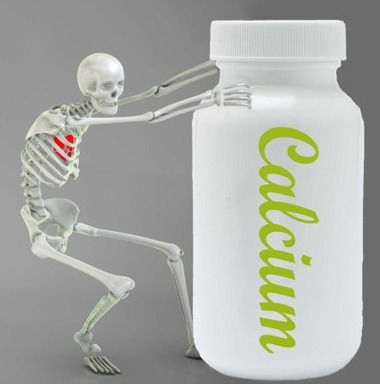Calcium Dance (Protocols)
 Sunday, September 6, 2020 at 11:25PM
Sunday, September 6, 2020 at 11:25PM PRECAUTION: WORK WITH AND COMMUNICATE TO YOUR MEDICAL DOCTOR BEFORE MAKING ANY CHANGES. THE INFORMATION HERE IS FOR NUTRITIONAL Maintenance AND NOT DISEASE TREATMENT.
CAUTION: Do not consume large amounts over 750 mg of calcium supplements (unless under Medical supervision) without first knowing your dietary calcium intake level, and second, your vitamin K status, with attention to K2. ref ref Vitamins K2 as MK4 and especially as MK7 are protective against calcium going into arteries leading to Cardiovascular damage. ref
Don't forget about magnesium levels that may be as imprtant as calcium amounts for proper calcium placement and functions.
For a Lifetime of Strong Bones
UPDATE: To benefit immediately from new research, limit calcium supplementation to no more than 600mg unless you know your dietary intake amount. The safest total amount with diet and supplement sources added together is between 600 mg to 1000 mg per day. Dietary daily calcium load is usually between 300 to 800 milligrams. Many foods are fortified with extra calcium, like orange juice and cereals, so supplemental calcium at 600mg may actually be a little high for some. To be fair, here is another study around the same time that arrived at what appears to be an opposite heading, that higher calcium is protective. BUT, look at the dosages for the higher and the truth is revealed (lower <458 mg/d for men, <417 mg/d for women versus the highest quartile of dietary calcium intake (>762 mg/d for men, >688 mg/d for women). ref Here is another study showing longer term benefits against osteoporosis but not for 3 year fracture prevention. ref (Note that the long term benefits were assumed and not a verified fact using just the measurement of increased bone density at 3 years.)
...YOU HAVE TO KNOW HOW MUCH DIETARY CALCIUM YOU CONSUME DAILY BEFORE YOU ADD CALCIUM SUPPLEMENTS. 1000-1200 mg minus dietary or food calcium intake determines how much or if you should supplement. ref If daily calcium intake is low, supplements may be necessary. BUT, if consumption is already high, little if any extra calcium supplementation is needed. The concept of supplement calcium load spike is involved here. Therefore, it is wise to take any supplemental calcium in small divided dosages. And never without sufficient vitamin D and vitamin K2, with MK7 preferred over MK4. Elimination of calcium in urine is a factor to acknowledge, but it varies with many different factors. It is a guide not a steady data point. Dietary calcium intake influences amounts and they vary from about 20-250 mg. with over 250 representing excess calcium elimination. Highest ever recorded was 741 mg. but this is rare. The urinary calcium level can be used to determine bone turnover rate. It is often elevated in osteoporosis and renal stone situations. ref ref
From the Harvard Medical School newsletter:
Calcium helps make strong bones, and vitamin D aids calcium absorption. Take a daily vitamin D3 supplement (D3 is the form most easily absorbed) between 600 to 1,000 IU, depending on your blood levels of vitamin D. For calcium, some evidence indicates that large doses of calcium pills may increase the risk of death from heart disease. (ref) So as much as possible, get calcium from food—dairy products*, leafy dark green vegetables, tofu, and sardines. The Recommended Dietary Allowance (RDA) of calcium for men ages 51 or older is 1,000 to 1,200 milligrams (mg) per day. For women ages 51 or older, it's 1,200 mg per day. ****If your diet doesn't provide enough calcium, take a low-dose calcium supplement to reach your RDA, but not exceed it.**** ref
*Dairy products do not contain enough magnesium to balance calcium in body. Be sure to supplement with some magnesium or add foods rich in magnesium.
REMEMBER: Add food calcium amount together with supplement amount to get to 1,000 or 1,200 milligrams per day. DO NOT SUPPLEMENT 1000 MG. ref The diet has between 300-700 mg. One serving of dairy usually has 300 mg.
Somehow, over a period of time, simple logic (and Science) lost out to marketing rhetoric in telling the bone health calcium story. At fault, science is not even following it's own scientific protocols in examining theories for credibility. The Calcium dance may be one of the most complex nutritional issues of our time. (Extreme view with merit under medical supervision- ref) More is not always better. ref cautions> ref Excellent general Calcium info from Harvard Medical> ref Bone info, ref
Calcium is vital to health.
 What you think are calcium facts are really marketing stories not entirely based on science, or at least not the whole picture but just small segments. Unless you have an understanding of the principles involved and correctly apply them, you are doomed to suffer mis-steps in the CALCIUM dance. Bones are just the tip of the iceberg for calcium actions, and while difficult to believe, calcium is not even among the top few recommendations from science for healthy strong bones. ref ref Does the cow look out of place in the jungle? Or is this a cow feeding paradise?
What you think are calcium facts are really marketing stories not entirely based on science, or at least not the whole picture but just small segments. Unless you have an understanding of the principles involved and correctly apply them, you are doomed to suffer mis-steps in the CALCIUM dance. Bones are just the tip of the iceberg for calcium actions, and while difficult to believe, calcium is not even among the top few recommendations from science for healthy strong bones. ref ref Does the cow look out of place in the jungle? Or is this a cow feeding paradise?
Here is a key bone basic from the US Surgeon General's report ref : "The bony skeleton is a remarkable organ that serves both a structural function, providing mobility, support, and protection for the body, and a reservoir function, as the storehouse for essential minerals."
The articles in this section illuminate some of the many factors about healthy bones:
- Calcium Driver > Blood levels, not bone density levels
- Kidney Mineral Balance
- Vitamin D and D gene polymorphisms
- Hormone Function - Parathyroid, Thyroid, Estrogen
- Rank, RANKL, OPG system of bone cell development and control
- Body Movement - Stress Torque on Bones
- Dietary Factors, especially Vegetables and Fruits
- Effects of chronic calcium supplement spikes in blood levels
- On minerals, potassium appears to play significant role for bone health in postmenopausal women. ref
From Harvard Medical website the following is copied due to it's importance:
In particular, these studies suggest that high calcium intake doesn’t actually appear to lower a person’s risk for osteoporosis. For example, in the large Harvard studies of male health professionals and female nurses, individuals who drank one glass of milk (or less) per week were at no greater risk of breaking a hip or forearm than were those who drank two or more glasses per week. (2, 3) When researchers combined the data from the Harvard studies with other large prospective studies, they still found no association between calcium intake and fracture risk. (4) Also, the combined results of randomized trials that compared calcium supplements with a placebo showed that calcium supplements did not protect against fractures of the hip or other bones. Moreover, there was some suggestion that calcium supplements taken without vitamin D might even increase the risk of hip fractures. A 2014 study also showed that higher milk consumption during teenage years was not associated with a lower risk of hip fracture in older adults. (27)
Here are study results mentioned above for milk drinkers exhibiting more hip fractures when 3 or more glasses consumed per day. Three glasses of milk could supply over 900 mg of calcium. But not nearly enough magnesium. Questions about study are also mentioned. Direction but not absolutes.
Copied next is a report from Italy, thus might not be completely USA similar, that shows supplemental calcium load has to be added to dietary amounts to get to 1000 - 1200 mg per day.
Dietary calcium and mineral/vitamin supplementation: a controversial problem.
Abstract
There is a consensus that adequate calcium intake during bone development, and possibly in adulthood and senescence, helps to prevent bone resorption and osteoporosis. The uptake of dietary calcium should be sufficient to maintain both normal serum calcium concentrations and parathyroid hormone levels in the low normal range throughout the day, otherwise, increased bone resorption occurs. Calcium intake varies with race and with environmental and dietary conditions. Estimating the appropriate amount of calcium to be added to dietary sources for an optimal supplementation regimen is therefore difficult. Few intervention studies have evaluated the dose-effect relationship for calcium supplementation conclusively. The mechanisms regulating fractional calcium absorption as a function of intake suggest that very high daily doses are probably useless. They may be unsafe in the long term because of the risks of hypercalciuria and kidney stones, and of an imbalance in the ratio of calcium to magnesium. Concomitant supplementation with limited amounts of magnesium may reduce this risk and improve mineralization. Dietary intake is 500-600 mg/day in most studies, making 400 mg/day an appropriate supplementary dose for most premenopausal women (RDA 1000 mg/day). After the menopause and during lactation (RDA 1200-1500 mg/day), 800 mg/day is probably appropriate, particularly if low doses of vitamin D are taken concomitantly. PMID:10417956
